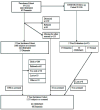Incidence and risk factors for cognitive impairment no dementia and mild cognitive impairment in African Americans
- PMID: 20921881
- PMCID: PMC3017665
- DOI: 10.1097/WAD.0b013e3181f1c8b1
Incidence and risk factors for cognitive impairment no dementia and mild cognitive impairment in African Americans
Abstract
The aim of this study was to estimate the age-specific incidence of cognitive impairment, no dementia and mild cognitive impairment (CIND/MCI) in a large, community-based sample of older African Americans in Indianapolis, IN. A longitudinal, prospective, 2-stage design was used with follow-up assessments 2 and 5 years after the baseline. A total of 1668 participants completed the 2-year follow-up and a total of 1255 participants completed the 5-year follow-up. The person-years method was used to calculate incidence rates. The age-standardized, annual incidence of CIND/MCI was 4.95% (CI=3.39-6.52) and the subtype of medically unexplained memory loss (single-domain and multidomain amnestic MCI) was 3.67% (CI 2.75-4.48). Rates increased with age (3.43% for participants aged 65 to 74 y, 6.44% from age 75 to 84 y, and 9.62% from age 85+ y), history of head injury [OR 2.37 (CI 1.31-4.29)], and history of depression [OR 2.22 (CI 1.16-4.25)] while increased years of schooling was protective [OR 0.91 (CI 0.85-0.97)]. Rates did not vary substantially by sex. Almost 1 in 20 elderly community-dwelling African Americans, and almost 1 in 10 of the oldest-old (85+ y) developed CIND/MCI each year in this cohort. Risk factors of age and education suggest exposures or mechanisms at both ends of the life span may be important variables in onset of CIND/MCI.
Copyright © 2011 by Lippincott Williams & Wilkins
Figures
References
-
- Graham JE, Rockwood K, Beattie LB, et al. Prevalence and severity of cognitive impairment with and without dementia in an elderly population. Lancet. 1997;349:1793–1796. - PubMed
-
- Unverzagt FW, Gao S, Baiyewu O, et al. Prevalence of cognitive impairment: Data from the Indianapolis Study of Health and Aging. Neurology. 2001;57:1655–1662. - PubMed
-
- Winblad B, Palmer K, Kivipelto M, et al. Mild cognitive impairment - beyond controversies, towards a consensus: report of the International Working Group on Mild Cognitive Impairment. Journal of Internal Medicine. 2004;256(3):240–246. - PubMed
-
- Petersen R. Mild cognitive impairment as a diagnostic entity. Journal of Internal Medicine. 2004;256(3):183–194. - PubMed
-
- DiCarlo A, Baldereschi M, Amaducci L, et al. Cognitive impairment without dementia in older people: Prevalence, vascular risk factors, impact on disability. The Italian Longitudinal Study on Aging. J Am Geriatr Soc. 2000;48:775–782. - PubMed
Publication types
MeSH terms
Grants and funding
LinkOut - more resources
Full Text Sources



